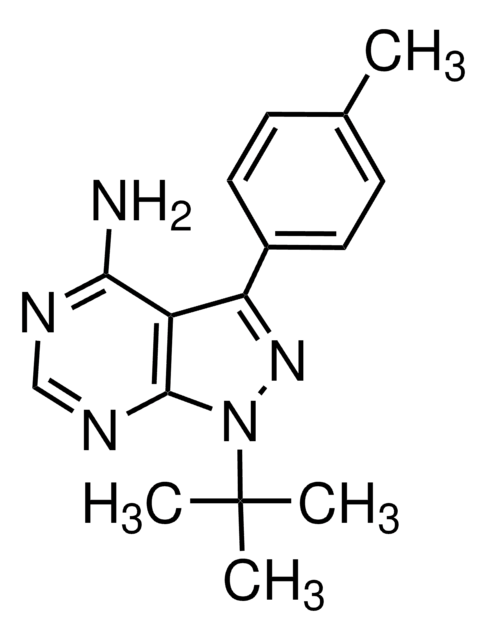529573
PP2
≥95% (HPLC), solid, Src protein tyrosine kinase inhibitor, Calbiochem®
Synonyme(s) :
PP2, AG 1879, 4-Amino-5-(4-chlorophenyl)-7-( t-butyl)pyrazolo[3,4-d]pyrimidine
About This Item
Produits recommandés
product name
PP2, PP2, CAS 172889-27-9, is a potent, reversible, ATP-competitive, inhibitor of the Src family of protein tyrosine kinases (IC₅₀ = 4, 5, 5, &100 nM for p56lck, p59fynT, Hck, & Src, respectively).
Niveau de qualité
Pureté
≥95% (HPLC)
Forme
solid
Fabricant/nom de marque
Calbiochem®
Conditions de stockage
OK to freeze
Couleur
off-white
Solubilité
DMSO: 20 mg/mL
Conditions d'expédition
ambient
Température de stockage
−20°C
InChI
1S/C15H16ClN5/c1-15(2,3)21-14-11(13(17)18-8-19-14)12(20-21)9-4-6-10(16)7-5-9/h4-8H,1-3H3,(H2,17,18,19)
Clé InChI
PBBRWFOVCUAONR-UHFFFAOYSA-N
Description générale
Actions biochimiques/physiologiques
p56lck
Conditionnement
Avertissement
Notes préparatoires
Autres remarques
Salazar, E.P., and Rozengurt, E. 1999. J. Biol. Chem. 274, 28371.
Hanke, J.H., et al. 1996. J. Biol. Chem.271, 695.
Selected Citations
Lee, J., et al. 2009. Cell Stem Cell5, 76.
Informations légales
Code de la classe de stockage
11 - Combustible Solids
Classe de danger pour l'eau (WGK)
WGK 3
Certificats d'analyse (COA)
Recherchez un Certificats d'analyse (COA) en saisissant le numéro de lot du produit. Les numéros de lot figurent sur l'étiquette du produit après les mots "Lot" ou "Batch".
Déjà en possession de ce produit ?
Retrouvez la documentation relative aux produits que vous avez récemment achetés dans la Bibliothèque de documents.
Les clients ont également consulté
Notre équipe de scientifiques dispose d'une expérience dans tous les secteurs de la recherche, notamment en sciences de la vie, science des matériaux, synthèse chimique, chromatographie, analyse et dans de nombreux autres domaines..
Contacter notre Service technique









